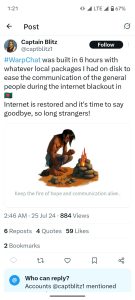In the midst of a sweeping nationwide internet shutdown imposed by the government of Sheikh Hasina during the July Movement in 2024, a small intranet-based communication app called WarpChat emerged as a lifeline for thousands of citizens, particularly young protesters who had been cut off from the digital world.
As Dhaka and other cities witnessed mass demonstrations demanding democratic reforms, the ruling regime responded with heavy force and a 10-day internet blackout from 18 July.
But WarpChat gave people their voices back.
“Being Gen-Z, I remember lying in bed the first night of the blackout thinking– when was the last time I slept without being online? I thought it’d last a few hours. It didn’t,” said the developer, who created WarpChat under the pseudonym CaptBlitz1 and has chosen to remain anonymous for safety reasons.
However, he had been known as Captain Blitz in social media.
The blackout severed communication for millions. For those working remotely or trying to coordinate on-ground responses to the crackdown, it triggered fear, frustration, and a desperate need to reconnect.
WarpChat provided the youth with an outlet to vent and communicate with their friends during a time of deep instability and uncertainty.
Built in isolation, deployed in defiance
With no access to the global internet, the developer used only offline tools and cached software packages to build the platform within six hours. Written in Node.js and deployed via Docker, the app was hosted on a BDIX (Bangladesh Internet Exchange)-connected server, a local network backbone that remained functional even as the external internet was blocked.
“It was like being stranded on an island. We had texts and phone calls– that was it. Communication felt like a privilege again. I knew I had to do something,” the developer told the Times of Bangladesh.
BDIX, a long-established infrastructure allowing local ISPs to exchange traffic within the country, became the invisible highway that kept WarpChat alive.

The app provided real-time messaging, group chats, and image sharing, effectively replacing mainstream apps like WhatsApp and Messenger for over 40,000 users.
A tool of survival and resistance
During its operational window, WarpChat saw the exchange of over 800,000 messages and more than 70,000 images. These included everything from coordination messages to photos documenting on-ground activities– and, in one case, e-books like “Amar fanshi chai” disguised as image files.
While the developer did not actively monitor usage, he observed signs that the app was being used to coordinate resistance activities.
“My main goal was to let people talk again. Whether it helped to organise protests– I can’t say for sure. But group names and shared content told their own story,” he said.
Despite lacking end-to-end encryption or SSL due to technical constraints, many users continued using WarpChat because, in that moment, privacy was secondary to the ability to communicate.
“A public notification was issued: the chats were not encrypted, use with caution. But even then, people kept using it– because the alternative was nothing.”
One person, one mission
WarpChat was built and maintained by a single individual, who developed and distributed it entirely on their own.
A friend assisted in securing a BDIX server, but the core infrastructure was constructed solo– often during power outages and under the looming threat of state surveillance.
The creator operated under the alias CaptBlitz1, keeping his identity protected while the app spread through SMS and word of mouth.
Why it ended and why it might never return
When the internet was restored on 28 July, WarpChat was shut down permanently.
All data, including messages, user-uploaded content, and user records, were deleted to protect those who had used the app, particularly in group chats where criticism of the regime was widespread.

“There were a lot of hateful messages. If the revolution failed, people could be at risk. I didn’t want that on my conscience,” said the developer, who many users later dubbed their “James Bond” or “Steve Jobs”.
Today, the app exists only in memory. There are no plans to revive it, but the creator points to Bluetooth-based offline messaging tools as a possible future alternative– if widely adopted.
Tech in the time of tyranny
When asked about the moral role of technology in times of crisis, the developer is unequivocal: technology is not neutral.
“When people’s safety and rights are at stake, we have a duty to build tools that empower and protect. It’s our moral responsibility.”
To young developers and tech activists in Bangladesh, his message is one of courage and contribution: Be a net positive. Give back to your community. Use your skills to solve real problems.
A personal account from a user of WarpChat describes the app as a vital source of communication during the blackout. It helped them coordinate with fellow protesters by sharing photos and updates from their respective areas.
It also offered a rare sense of comfort and solidarity, as friends used the app to play games like UNO and share their fears while violence and tension raged outside.
WarpChat was never meant to be permanent.
It was a digital campfire in the middle of a manufactured blackout, a space where people found each other again in the dark.
It now stands as a striking example of how grassroots innovation can momentarily outpace state control, and why connection, in any form, remains one of the most powerful tools in times of repression.


